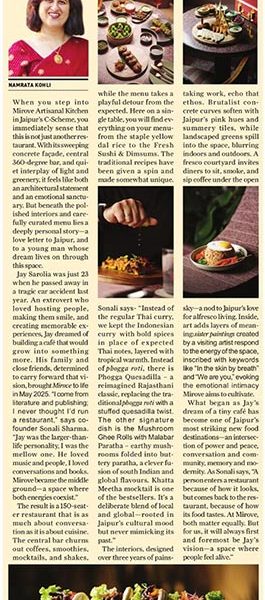The Northwest frontier cuisine is headlined by marinated kebabs and a lot of lamb-based dishes. Typically, low on spices and yet flavourful, the cuisine is distinct with its technique of slow cooking and grilled method in clay oven
“I’m particularly fond of Northwest Frontier cuisine, also known as ‘cuisine of the Pathans’, which originates from the historic Northwest Frontier Province. What sets it apart is its distinctive cooking technique, characterized by minimal marination and slow cooking at high temperatures, which brings out the inherent flavours of the ingredients,” says Zeeshan Ali, a Delhi based food and hospitality consultant who is an ardent fan of Frontier food. Says Ali- “The judicious use of spices allows the meat to shine, without being overpowered by bold seasonings. This approach not only preserves the nutritional value of the dishes but also makes them wholesome and delectable.” His all-time favourites include mutton rezala, dal makhani, raan e alishan, and pathar kebabs.
Originating from the North-West Frontier Province (now Khyber Pakhtunkhwa) in Pakistan, this region is historically significant as it lies on the border of Pakistan and Afghanistan and cuisine is known for its simplistic yet flavourful style of preparation. It involves large chunks of meat or vegetables, sparsely marinated, and slow cooked in a tandoor at high temperatures. The use of spices is balanced to enhance the natural flavours of the ingredients. This is essentially food of the northwest frontier, the Pashtuns or Paktun people who spoke Pashto, who were essentially the nomadic tribe and hence this was nomadic food with more open pitfire cooking kebabs.
‘Where the men are tough but the lamb is tender’ … so goes the story of Northwestern food which has many fans, globally. No wonder, hotels like The Ashok New Delhi hosted Khyber Ki Peshkash festival recently with the Kohat Platter comprising paneer tikka, tandoori khumb, subz e seekh (priced at Rs. 1200), the Khyber Platter (Rs. 1700) comprising fish tikka, murg hazarvi tikka and chapli kebab and the raan alishaan combo meal for Rs. 2,500.
There is a significant focus on meats, especially lamb, and chicken, prepared in a variety of ways including grilling, roasting, and braising. Says Chef Sanjay, Executive Chef- The Ashok, New Delhi, “As the chefs at the Ashok Hotel, we use high-quality meat and a secret blend of spices to create these delectable kebabs. The result is a perfectly charred and juicy kebab that is packed with flavour. The addition of saffron and rose petals adds a touch of elegance to this rustic dish, making it a must-try for any food lover.” He shares that both patthar ka kebab and chapli kebab may seem like simple dishes, but the techniques used to cook them, and the selection of ingredients make them stand out. “These dishes are not just about the flavours; they are about the experience. The hot stone and flat grill cooking methods add a unique element to the dish, making it an interactive experience for diners. Apart from the cooking methods, what sets these dishes apart is the quality of the ingredients used. From the meat to the spices, every element is carefully selected to ensure that our guests have an unforgettable dining experience,” says Chef Sanjay.
Bukhara, ITC Maurya, Peshawri – ITC Sonar, Khyber, Zaffran, Dum Pukht, Indian Accent, Kebabs & Kurries, Gulati’s are some of the popular restaurants serving this cuisine. “At Gulati’s, our bestselling dishes in Northwest Frontier cuisine include the renowned butter chicken, dal makhani, biryanis and our flavorful Kebabs. Over the years, we have observed a steady increase in the demand for Frontier food as more people seek out authentic, hearty meals. To cater to contemporary tastes, we’ve introduced lighter, healthier options and innovative twists on traditional recipes, ensuring that our menu evolves while preserving the essence of our rich culinary heritage,” says Namit Gulati, Owner at Gulati Restaurant, Pandara and Gurgaon.
The emphasis is on simple, fresh ingredients without the use of heavy sauces or complex cooking methods. Many dishes use yogurt as a base for marination, combined with spices like cumin, coriander, and garam masala. The marination process not only infuses flavours but also tenderizes the meat, making it succulent. Fresh herbs and spices such as ginger, garlic, and chilies are commonly used in marinades.
Sanjeev Kapoor, a chef, television presenter and entrepreneur, talks of his deep association with Northwest Frontier Cuisine. Says Chef Kapoor- “My dad was born there. He was born in Peshawar, which is in the northwest frontier area. So, I have, in some sense, the right legacy to talk about the northwest frontier. Not that I have lived there, but the family, the stories from my dad’s sisters and uncle, all of that. There is something I was curious about, because my first job was in ITDC, Ashok group of hotel and northwest frontier cuisine in India, the two places which made it famous. One, of course, was obvious, Bukhara restaurant. And second, Ashok with two iconic chefs Madan Lal Jaiswal (Bukhara), and at Khadak Singh (Frontier) who was a champion, I can say. And I was lucky to be trained there in the northwest frontier. But I think the influence of open spitfire cooking, cooking on charcoal, cooking on wood, meats cooked like that, whether cooked in open fire or cooked in tandoor, I think that this is the real essence.”
He talks about the evolution of frontier food and how what is served today is quite different from the original. Says Chef Sanjeev Kapoor- “Today how the spices, the way it is cooked is very different from what you would actually get there in that region. It’s actually mostly boiled, non-spicy food is what people eat there- meats and vegetables cooked together, it’s kind of a stew, which is not at all spicy and bland- at best kind of pahadi food, you could say, what would be available there. So that’s largely the influence of real northwest frontier cuisine. But in India, we popularized tandoori kebabs and that worked with the Indian spices, different marinates.” Kapoor has done some real work on this and talks about the two main original dishes at frontier- hazarwi kebab and banno kebab– which were in some sense names of places from there. While hazarwi kebab was made with the cream and cheese chicken breast, banno kebab was finished with egg finally…a version of what people say, reshmi kebab. And they continue to be popular. And of course, dal which we call as maa ki dal, is called marsh there, actually. It’s black urad that became popular with tomato and ghee and butter.”
The kali dal is the longest cooked dal in the world. The combination of whole black lentils (urad dal), tomatoes, ginger and garlic — is cooked and simmered over the slow coal fire of the tandoor overnight for 18 hours at a stretch!
There is also a distinct culture of serving Northwest frontier cuisine. “While dining, guests are encouraged to eat with their hands to experience the food through all their senses. Cutlery is not laid out on the table, and only provided if asked for and crockery made of copper/heavy steel thalis, adds to the rustic charm,” says Mumbai based food blogger, 27-year-old Asmita Nagpal.
PRICE CHART
If you savour frontier cuisine, then opt for a meal at one of these top-rated restaurants serving Northwest Frontier cuisine in India
| Restaurant Name | Location | Approximate Cost for Two (₹) |
| Bukhara, ITC Maurya | New Delhi | 8,000 |
| Frontier – The Ashok | New Delhi | 4,000 |
| Peshawri – ITC Sonar | Kolkata | 3,000 |
| Khyber | Mumbai | 3,000 |
| Zaffran | Mumbai | 2,000 |
| Dum Pukht, ITC Maurya | New Delhi | 8,000 |
| Gulati | New Delhi | 2,500 |
| Kebabs & Kurries, ITC Hotel | Bengaluru | 4,500 |
| Barbeque Nation | Multiple locations | 2,500 |
| Indian Accent | New Delhi | 6,000 |




